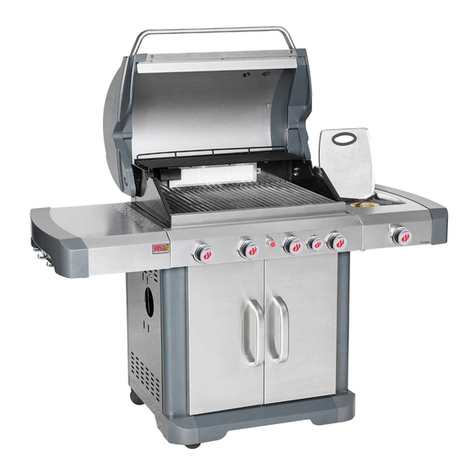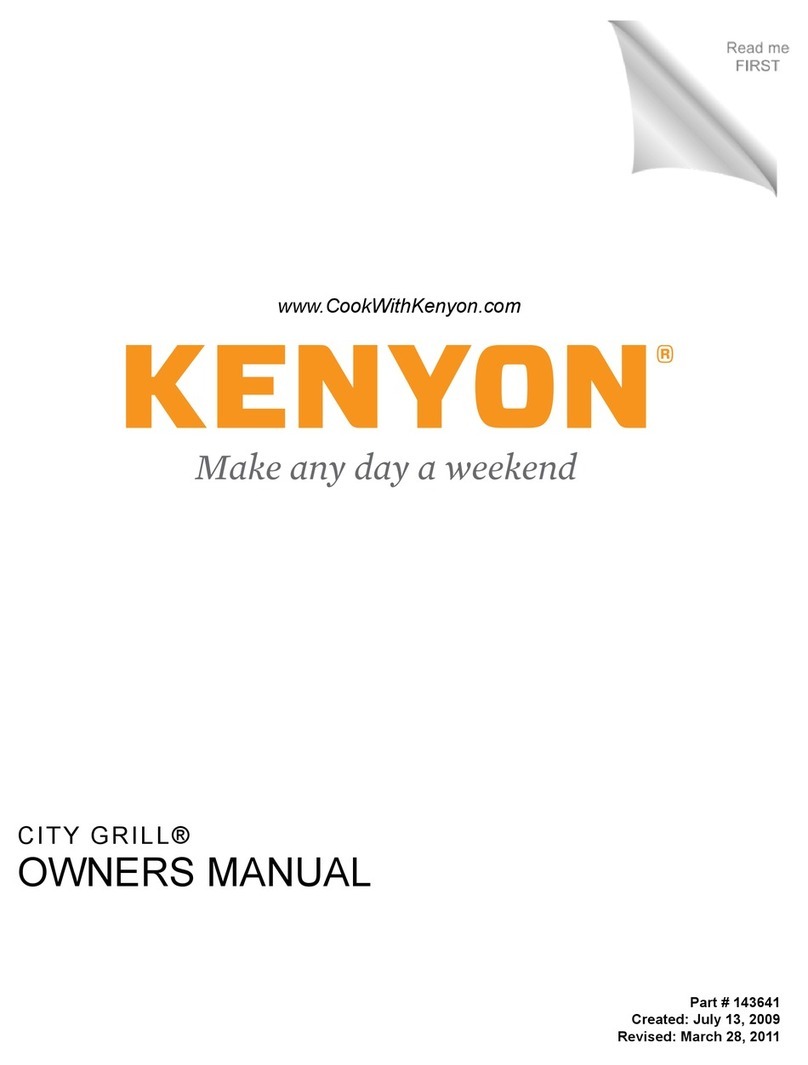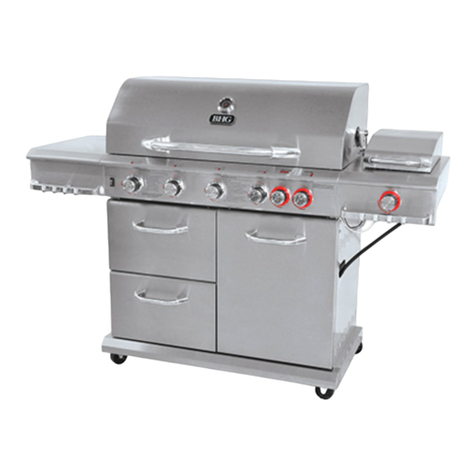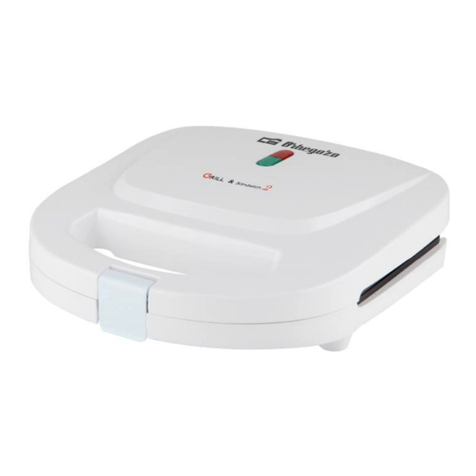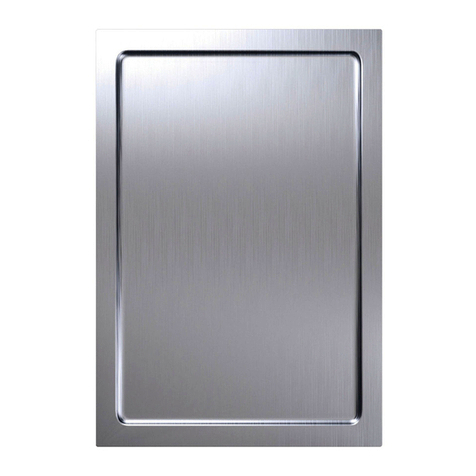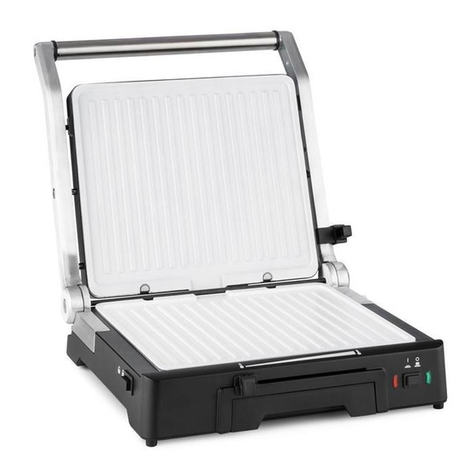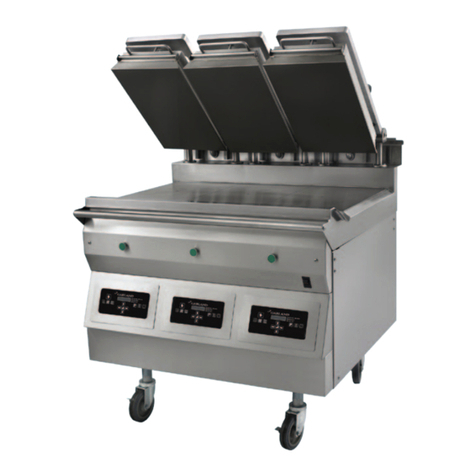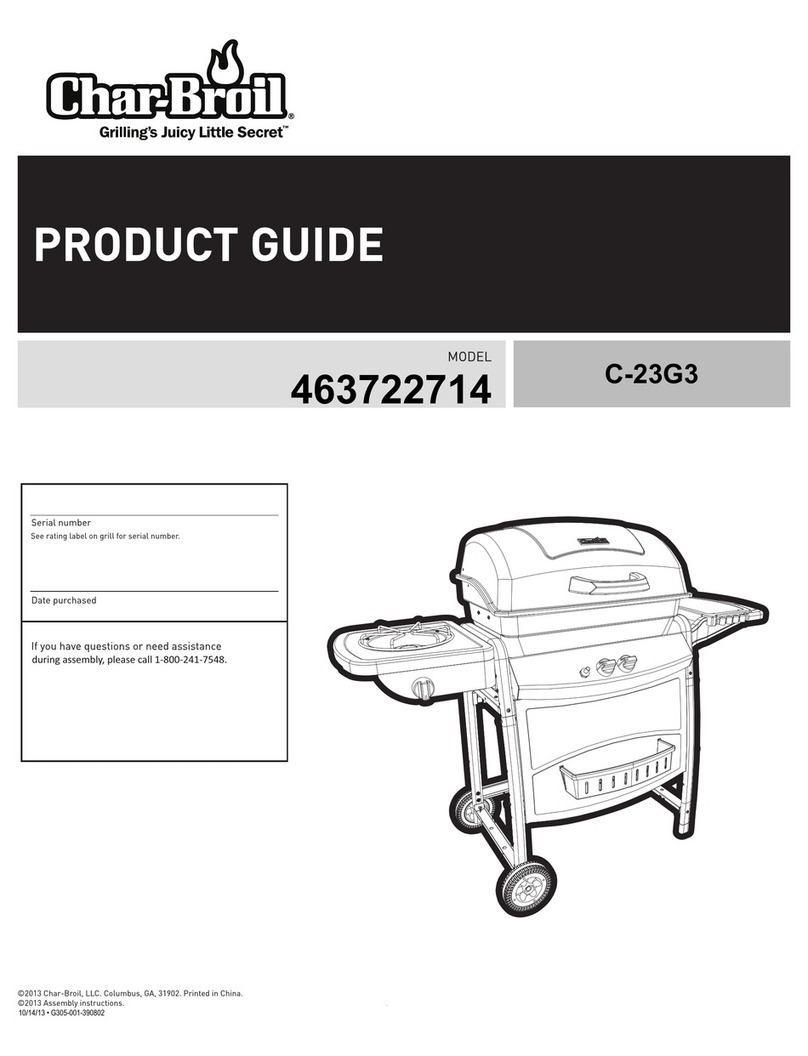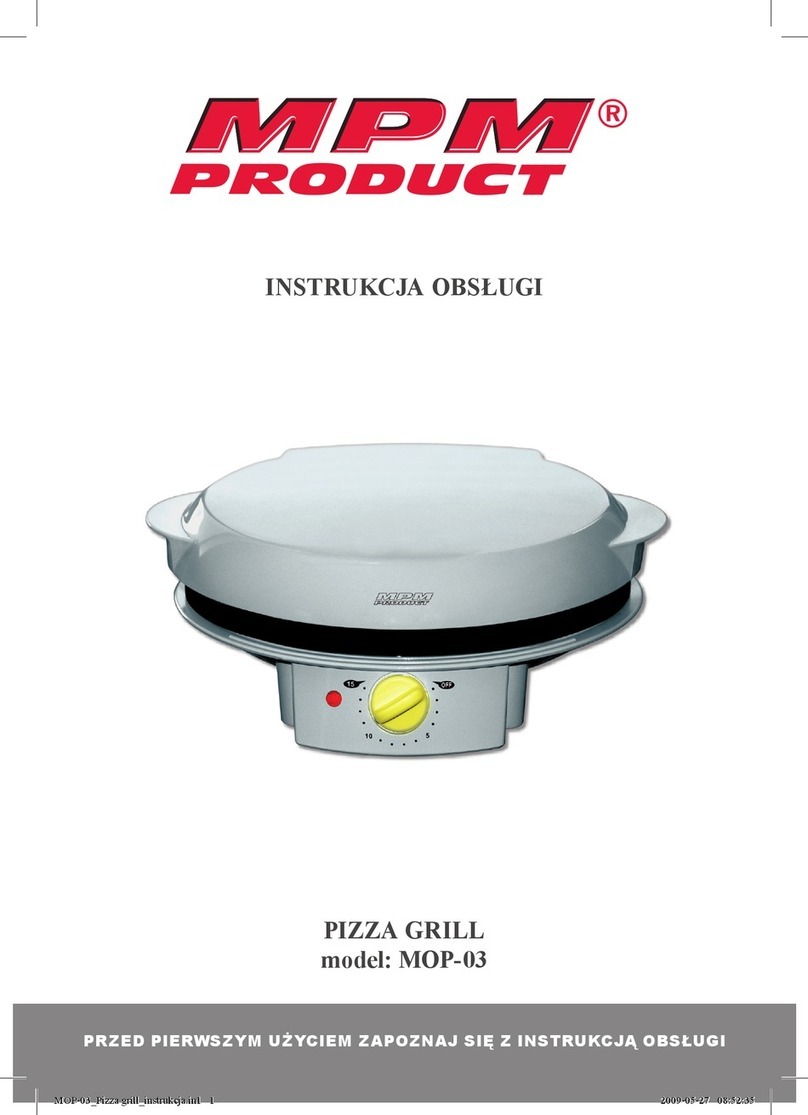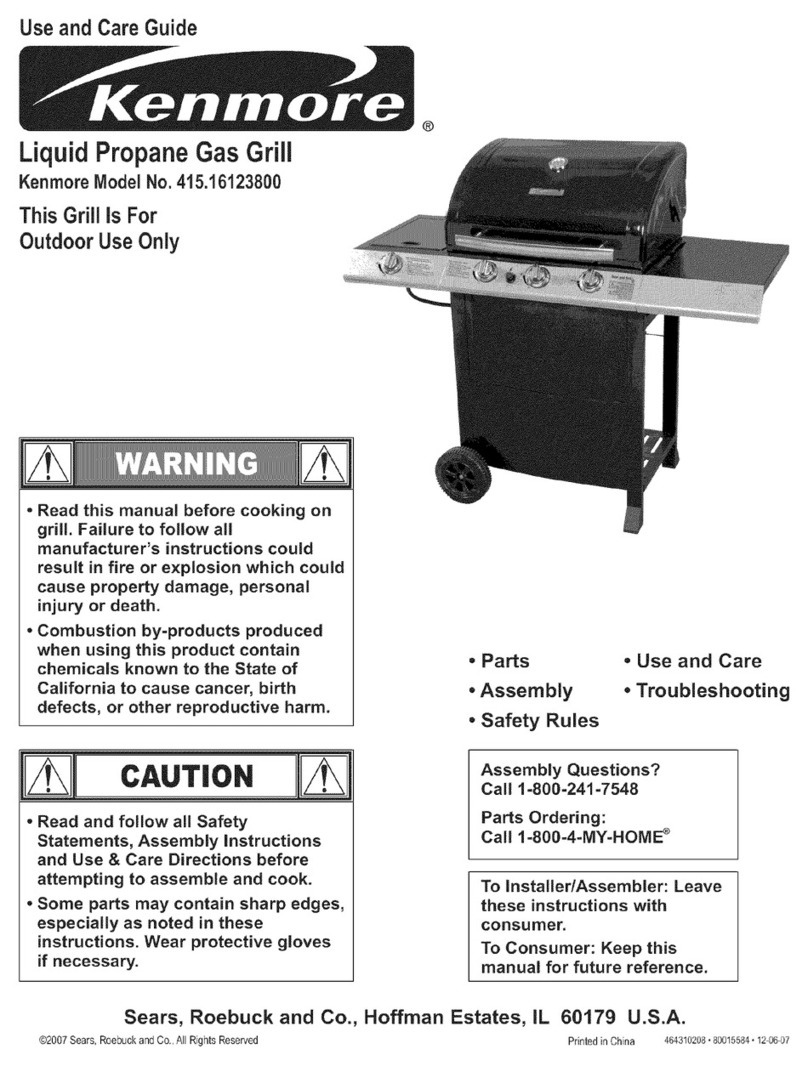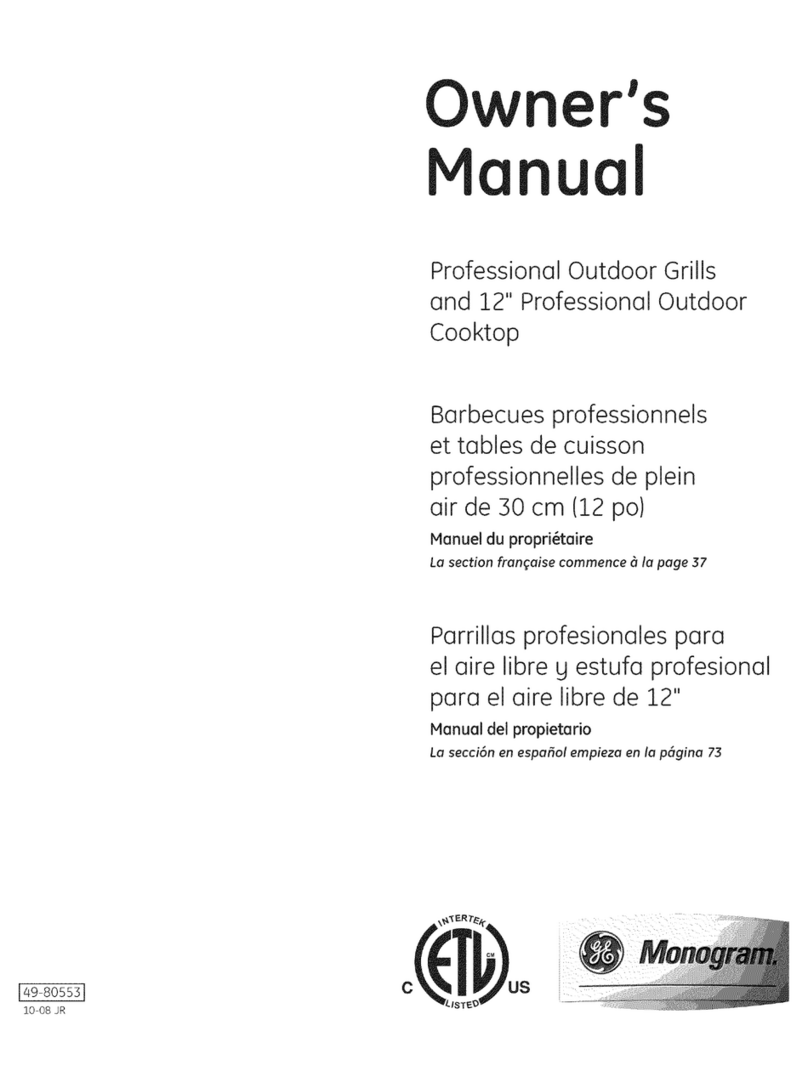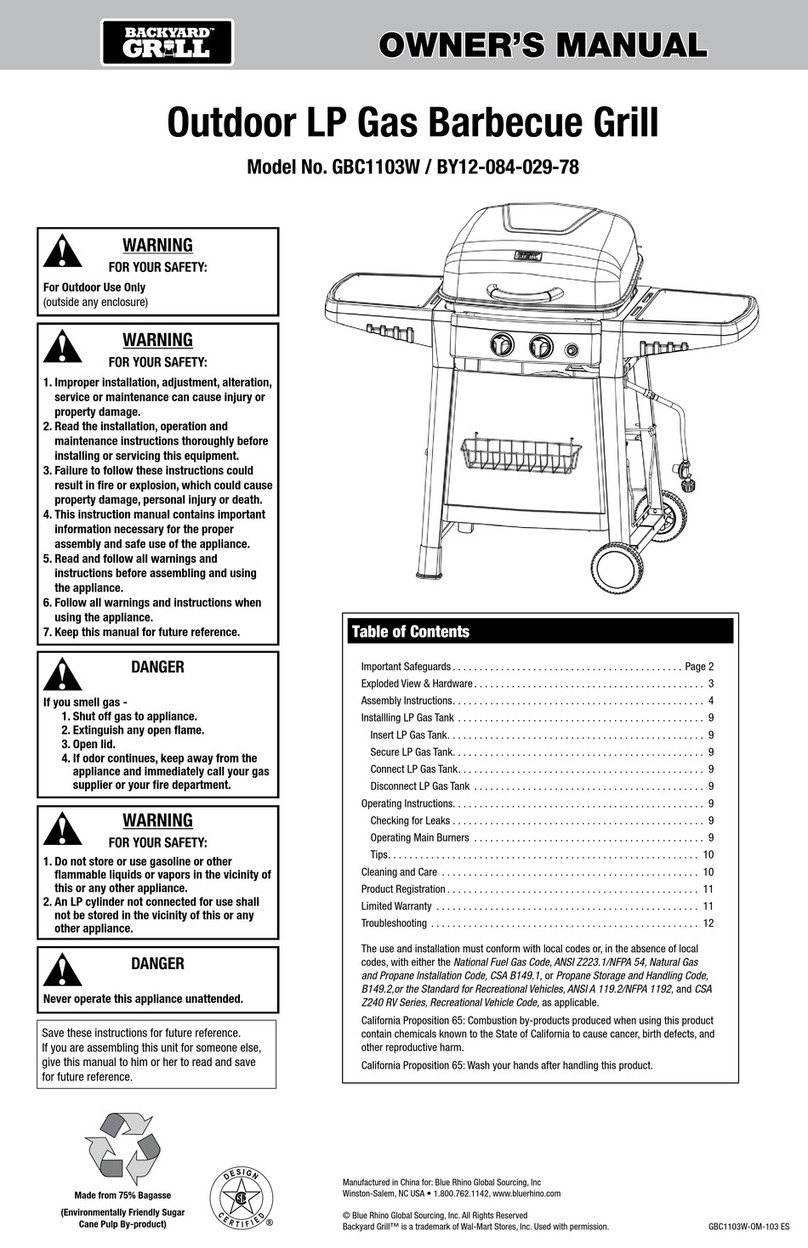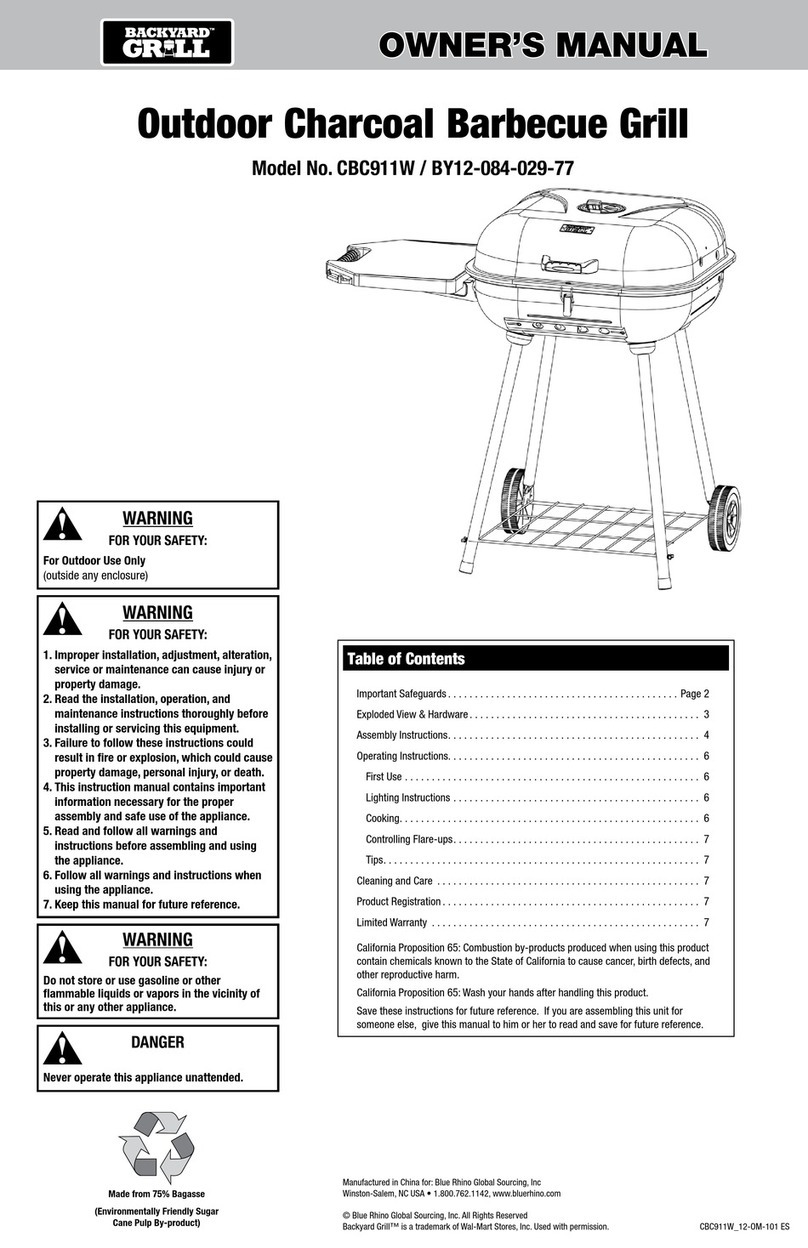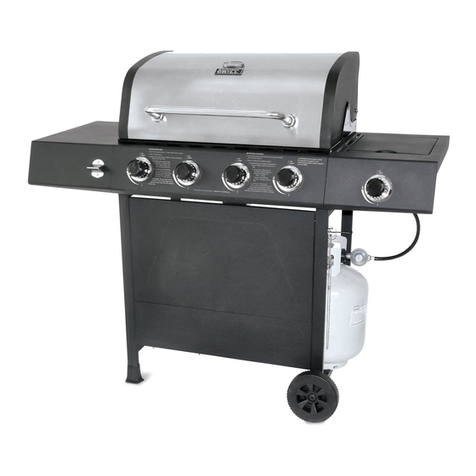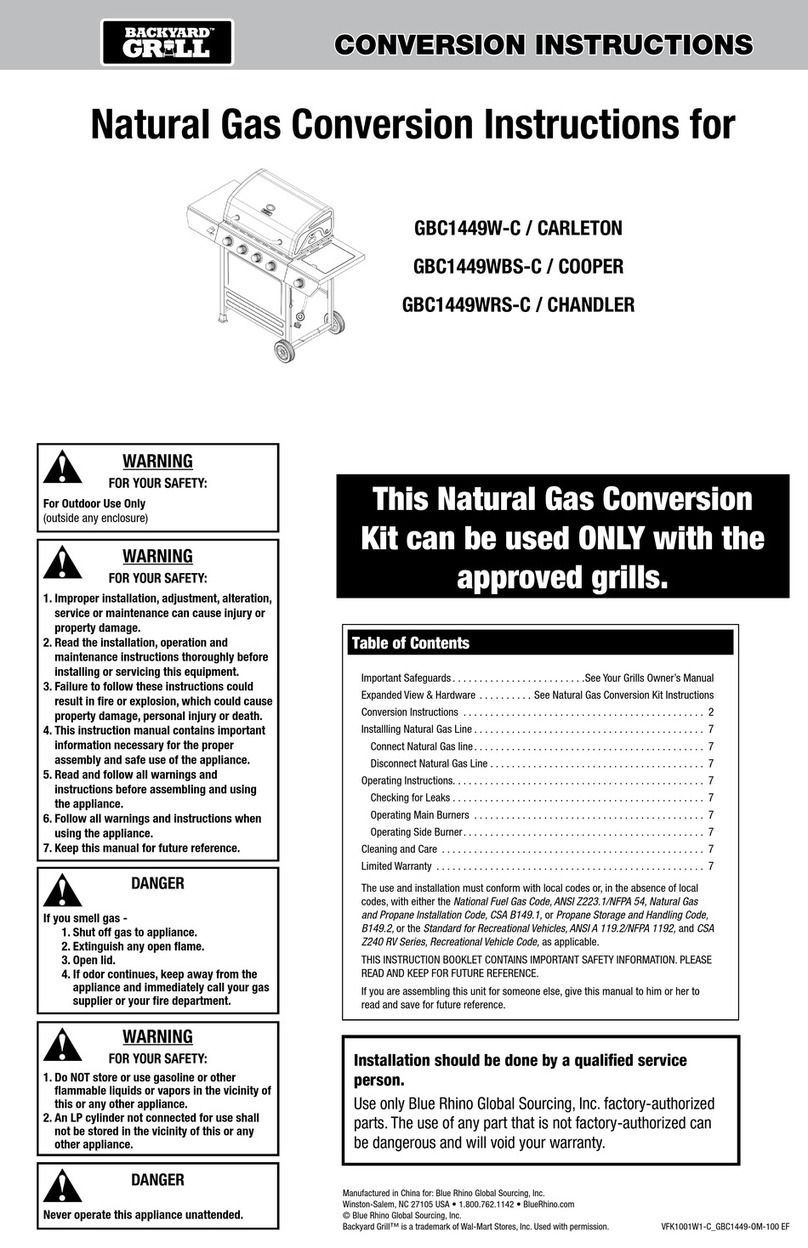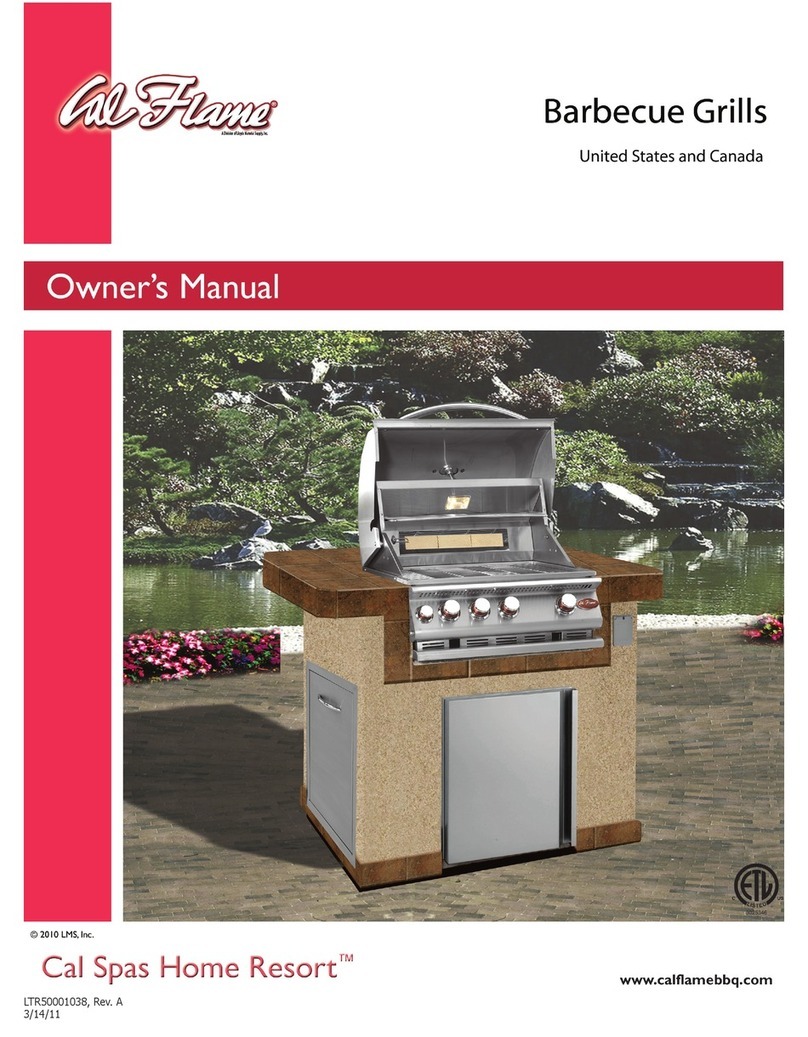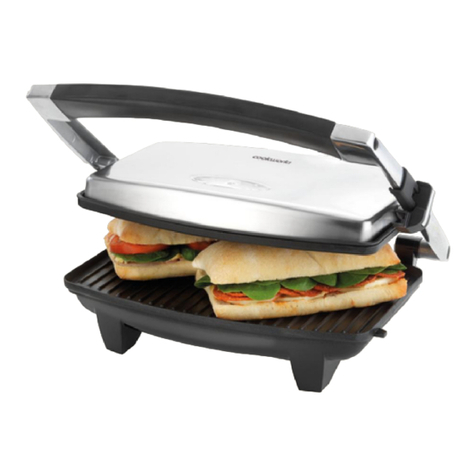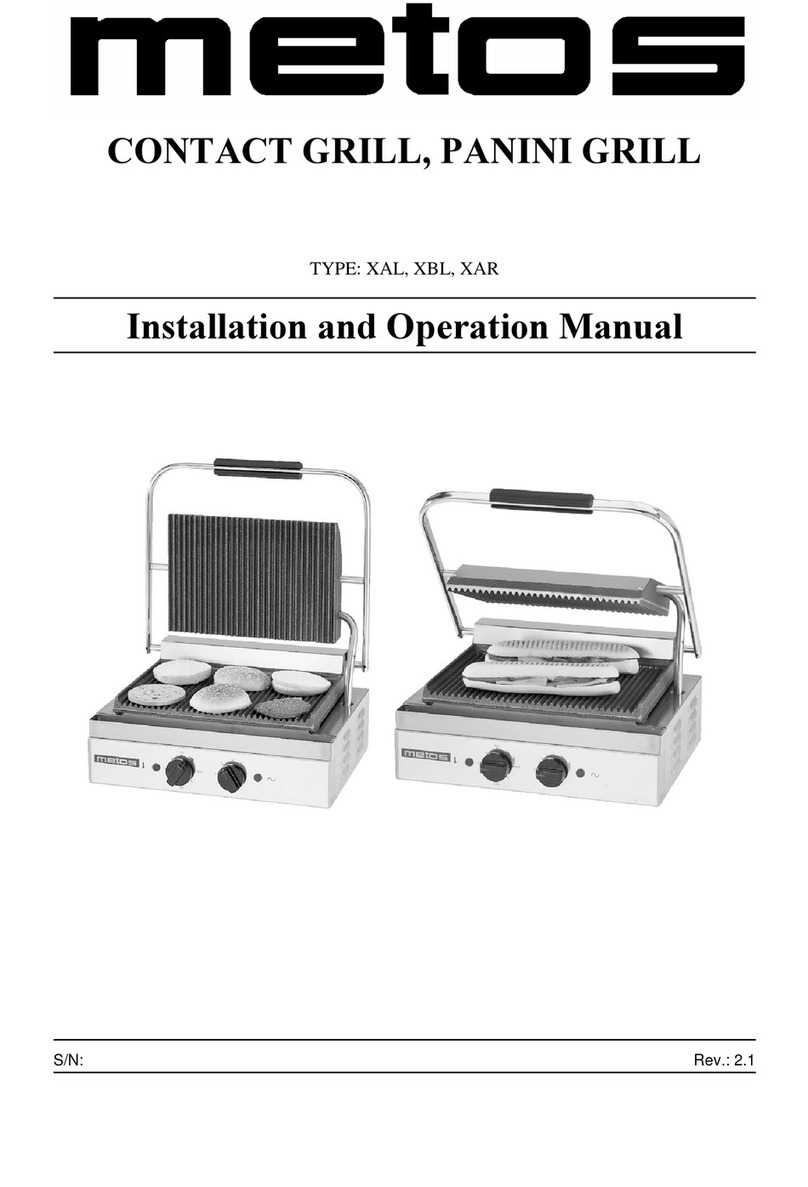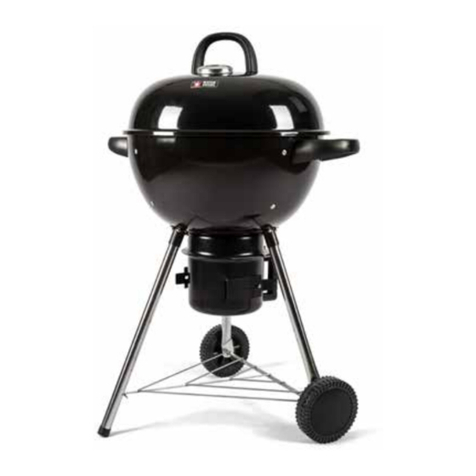
Outdoor LP Gas Barbecue Grill
Model No. GBC1429W / BY14-101-001-01
2
WThis grill is for outdoor use only, and should not be used in a building,
garage or any other enclosed area.
WDo NOT operate, light or use this appliance within ten feet (3.05 m) of
walls, structures or buildings.
WFor residential use only. This grill is NOT for commercial use.
WThis grill is not intended for and should never be used as a heater. TOXIC
fumes can accumulate and cause asphyxiation.
WThis grill is safety certified for use in the United States and/or Canada
only. Do NOT modify for use in any other location. Modification will
result in a safety hazard and will void your warranty.
WThis grill, from the factory, is for use with liquid propane (LP) gas only.
The conversion to or attempted use of natural gas in this LP gas grill is
dangerous, may cause bodily harm and will void your warranty.
WLP gas characteristics:
a. LP gas is flammable and hazardous if handled improperly. Become
aware of the characteristics before using any LP gas product.
b. LP gas is explosive under pressure, heavier than air, and settles/
pools in low areas.
c. LP gas in its natural state has no odor. For your safety, an odorant is
added that smells like rotten cabbage.
d. Contact with LP gas can cause freeze burns to skin.
WApartment dwellers: Check with management to learn the requirements
and fire codes for using a LP Gas grill in your apartment complex.
If allowed, use outside on the ground floor with a ten foot (3.05 m)
clearance from any structure. Do NOT use on or under balconies.
WLP gas cylinder needed to operate. Only cylinders marked “propane”
may be used.
WThe LP gas cylinder must be constructed and marked in accordance
with the Specifications for LP-gas Cylinders of the U.S. Department
of Transportation (D.O.T.) or the National Standard of Canada, CAN/
CSA-B339, Cylinders, Spheres and Tubes for the Transportation of
Dangerous Goods; and Commission.
WLP gas cylinder must be arranged for vapor withdrawal.
WThe LP gas cylinder must have a listed overfilling prevention device
(OPD).
WOnly use LP gas cylinders equipped with a cylinder connection device
compatible with the connection for outdoor cooking appliances.
WThe LP gas cylinder must have a cylinder collar to protect the cylinder
valve.
WNever use a LP gas cylinder with a damaged body, valve, collar or
footing.
WDented or rusted LP gas cylinders may be hazardous and should be
checked by your LP gas supplier prior to use.
WThe LP gas cylinder should not be dropped or handled roughly.
WLP gas cylinders must be stored outdoors out of the reach of children
and must not be stored in a building, garage or any other enclosed area.
Your cylinder must never be stored where temperatures can reach over
125°F.
WDo NOT insert any tool or foreign object into the valve outlet or safety
relief valve. You may damage the valve and cause a leak. Leaking
propane may result in an explosion, fire, severe personal injury or death.
WDo NOT block holes in sides or back of grill.
WNever keep an LP gas cylinder in a hot car or trunk. Heat will cause the
gas pressure to increase, which may open the relief valve and allow gas
to escape.
WPlace dust cap on cylinder valve outlet whenever the cylinder is not in
use. Only install the type of dust cap on the cylinder valve outlet that is
provided with the cylinder valve. Other types of caps or plugs may result
in leakage of propane.
WIf grill is not in use, the gas must be turned off at the supply cylinder
and disconnected.
WDo NOT store a spare LP gas cylinder under or near this appliance.
WNever fill the cylinder beyond 80 percent full.
WA fire causing serious injury or damage to property may occur if the
above is not followed exactly.
WNever attempt to attach this grill to the self-contained LP gas system of
a camper trailer, motor home or house.
WNever use charcoal, lighter fluid, lava rocks, gasoline, kerosene or
alcohol with this product.
WYour grill has been checked at all factory connections for leaks.
Recheck all connections as described in the “Operating Instructions”
section, as shipping can loosen connections.
WCheck for leaks even if your unit was assembled for you by someone
else.
WDo NOT operate if a gas leak is present. Gas leaks may cause a fire or
explosion.
WYou must follow all instructions in “Checking for Leaks” section before
operating. To prevent fire or explosion hazard when testing for a leak:
a. Always perform a leak test before lighting the grill and each time
the cylinder is connected for use.
b. No smoking. Do NOT use or permit sources of ignition in the area
while conducting a leak test.
c. Conduct the leak test outdoors in a well-ventilated area.
d. Do NOT use matches, lighters, or a flame to check for leaks.
e. The use of alcohol, prescription or non-prescription drugs may
impair the consumer’s ability to properly assemble or safely operate
the appliance.
f. Strong odors, colds, sinus congestion, etc. may prevent the
detection of propane. Use caution and common sense when testing
for leaks.
g. Do NOT use grill until any and all leaks are corrected. If you are
unable to stop a leak, disconnect the LP gas supply. Call a gas
appliance serviceman or your local LP gas supplier.
WThis grill is designed to operate at an inlet pressure of: 11 inches water
column.
WDo NOT store or use gasoline or other flammable liquids or vapors
within 25 feet (7.62 m) of this appliance.
WDo NOT use in an explosive atmosphere. Keep grill area clear and free
from combustible materials, gasoline and other flammable vapors and
liquids.
WMinimum clearance from sides and back of unit to combustible
construction is 36 inches (91.4 cm). Do NOT use this appliance under
any type of overhang or roof.
WIt is essential to keep the grill’s valve compartment, burners and
circulating air passages clean.
WInspect grill before each use.
WDo NOT alter grill in any manner. Any alteration will void your warranty.
WDo NOT use the grill unless it is COMPLETELY assembled and all parts
are securely fastened and tightened.
WDo NOT build this model of grill in any built-in or slide-in construction.
Ignoring this warning could cause a fire or an explosion that can
damage property and cause serious bodily injury or death.
WThis grill should be thoroughly cleaned and inspected on a regular
basis.
WClean and inspect the hose before each use of the appliance. If there
is evidence of abrasion, wear, cuts or leaks, the hose must be replaced
prior to operation.
WUse only the regulator and hose assembly provided. Use only the
replacement regulator and hose assembly specified by Blue Rhino
Global Sourcing, Inc.
WUse only Blue Rhino Global Sourcing, Inc. factory authorized parts. The
use of any part that is not factory authorized can be dangerous and will
void your warranty.
WDo NOT operate this appliance without reading “Operating Instructions”
in this manual.
WDo NOT touch metal parts of grill until they have completely cooled
(about 45 min.) to avoid burns, unless you are wearing protective gear
(pot holders, gloves, BBQ mittens, etc.).
WDo NOT install or use in or on boats or recreational vehicles.
WDANGER: Failure to follow the dangers, warnings and cautions in this manual may result in serious bodily injury or death, or in a fire or an explosion causing damage
to property.
WWARNINGS:
Important Safeguards
